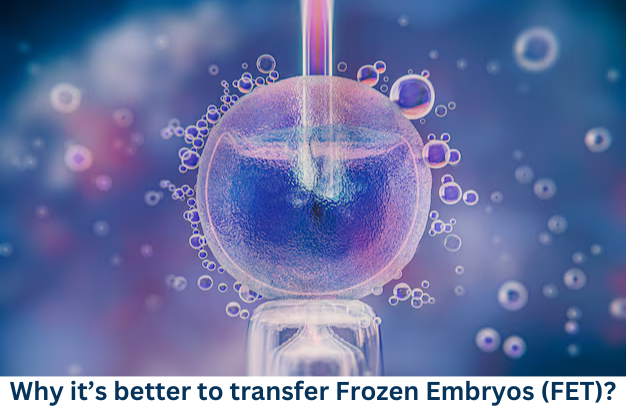Why it’s better to transfer Frozen Embryos (FET)?
In the realm of fertility treatments, Frozen Embryo Transfer (FET) has emerged as a popular and often more successful option compared to fresh embryo transfers. This technique involves freezing embryos and transferring them to the uterus at a later time. At New World Fertility Centre in Delhi, we specialize in FET, leveraging its numerous advantages to help couples achieve their dream of parenthood.
Understanding FET
FET involves several key steps:
Egg Retrieval and Fertilization: This initial phase is similar to a fresh IVF cycle, where eggs are retrieved from the ovaries and fertilized with sperm in a laboratory setting.
Embryo Freezing: The resulting embryos are carefully frozen using advanced techniques like vitrification, preserving their viability for an extended period.
Uterine Preparation: Before the transfer, the uterus is prepared to receive the embryo through hormone therapy.
Embryo Transfer: The frozen embryo is thawed and gently transferred into the uterus using a thin catheter.
Benefits of FET
FET offers several compelling advantages over fresh embryo transfers:
1. Improved Success Rates: Studies have consistently shown that FET often results in higher pregnancy and live birth rates compared to fresh transfers. This is attributed to several factors, including:
- Reduced Risk of Ovarian Hyperstimulation Syndrome (OHSS): The hormonal stimulation required for fresh transfers can sometimes lead to OHSS, a potentially serious condition. FET eliminates this risk by allowing the ovaries to recover before the transfer.
- Optimized Uterine Lining: Freezing embryos provides time to carefully monitor and prepare the uterine lining for optimal implantation.
- Genetic Testing: FET allows for preimplantation genetic testing (PGT) of embryos, enabling the selection of healthy embryos with a higher chance of success.
2. Increased Flexibility: FET offers greater flexibility in terms of timing. Couples can choose when to proceed with the transfer based on their personal circumstances, work schedules, or other factors.
3. Multiple Transfer Opportunities: If the initial FET is unsuccessful, frozen embryos can be thawed and transferred again, increasing the chances of pregnancy.
4. Cost-Effective: FET can be more cost-effective than multiple fresh IVF cycles, as the initial egg retrieval and fertilization can be used for several transfers.
5. Preservation of Fertility: FET allows couples to preserve their fertility for future use, such as in cases of cancer treatment or delayed family planning.
FET at New World Fertility Centre
At New World Fertility Centre, we are committed to providing the highest quality FET services. Our experienced team of fertility specialists and embryologists utilizes state-of-the-art techniques and equipment to ensure optimal outcomes. We offer personalized care and support throughout the entire FET process, from initial consultation to pregnancy confirmation.
Conclusion
FET has become a preferred choice for many couples seeking fertility treatment. Its numerous advantages, including improved success rates, increased flexibility, and cost-effectiveness, make it a compelling option. If you are considering fertility treatment, FET may be the right choice for you. Contact New World Fertility Centre in Delhi to learn more about our FET services and schedule a consultation.
FAQs
1. What is Frozen Embryo Transfer (FET)?
FET is a procedure in which previously frozen embryos are thawed and transferred into a woman's uterus during a cycle following the initial IVF treatment. This allows for more flexibility in timing and can enhance the chances of a successful pregnancy.
2. How are embryos frozen?
Embryos are frozen through a process called cryopreservation, which involves cooling the embryos to extremely low temperatures to stop all biological activity. This allows them to be stored for future use without significant loss of viability.
3. Why should I consider FET over a fresh embryo transfer?
FET has several advantages, including improved success rates, reduced risk of Ovarian Hyperstimulation Syndrome (OHSS), better timing for transfer, and the ability to select the highest quality embryos. Additionally, FET can provide psychological benefits by allowing couples time to prepare for pregnancy.
4. Are frozen embryos as viable as fresh embryos?
Yes, numerous studies have shown that frozen embryos can be just as viable as fresh embryos, and in some cases, FET can lead to higher success rates. The technology for freezing and thawing embryos has advanced significantly, improving outcomes.
5. What are the steps involved in the FET process?
The FET process typically includes the following steps:
- Preparation of the uterine lining through hormone therapy.
- Thawing of the frozen embryos.
- Transferring the thawed embryos into the uterus using a thin catheter.
- Monitoring for pregnancy through blood tests and ultrasounds.

 Oct-15-2024
Oct-15-2024